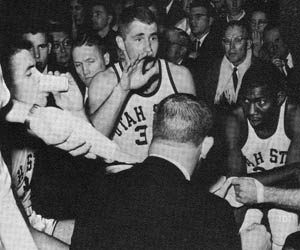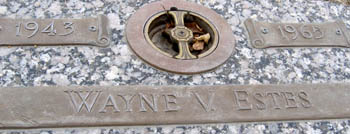Forty years later: Wayne Estes remembered
Forty years after the death of Utah State basketball star Wayne Estes, people are still talking about him.
“Forty years … and this is still going on,” Delano Lyons, Estes’ close friend and former roommate, said. “Does that tell you anything about Wayne? Forty years later people are still bringing this up. People are still asking about Wayne Estes. This is still a big deal to some people.”
Long before the NCAA named him an All-American athlete, Estes was the all-american boy to his family, friends and nearly everyone he came in contact with at Utah State.
Estes came to Utah State to play basketball in 1961. After four years of record-breaking play for the Aggies, he was well on his way to becoming what Lyons said would be one of the greatest pro basketball players.
But, with only five games left in his senior season, Estes was tragically killed on Feb. 8, 1965 and Cache Valley lost its hero.
Lyons said over the years many athletes can die, but none are remembered as well as Estes. The type of person Estes was, on and off the court, combined with his tragic death has made the “legacy of Wayne Estes” continue, he said.
February 8, 1965
It was one of the biggest nights in his basketball career.
There were only six games left in the regular season and the Anaconda, Mont., native was close to breaking the 2,000 career points barrier.
Reid Andreasen, the radio announcer for the Aggies when Estes played, said that night was an interesting one. At first, he said, Estes didn’t make very many shots, but after a while, it seemed like everything he threw up went in.
“That’s how I remember Wayne. In the corner on the baseline, faking one way and turning around and hooking the ball up over his head and scoring,” Andreasen said.
Estes scored 48 points that night, the last coming from one of his famous hook shots 15 feet away from the basket. It was a Nelson Fieldhouse record and enough to move past the 2,000-point mark in his career.
It was the last basket Estes made.
After he broke the record, his coach, Ladell Andersen, took him out for the final minutes of the game.
Two hours after the game, Estes and some friends stopped to look at a car accident that had happened earlier in the evening.
Because the car hit a telephone pole, a wire was haging down a little more than 6 feet off the ground.
As Estes and Lyons were walking toward the scene of the accident, Lyons walked under the wire. He turned to warn Estes to duck, but Estes walked right into it.
“[It was like] cartoons where the cat sticks its tail in an outlet and lights up. People around us said that’s what we looked like.”
Lyons said when Estes grabbed the wire he also reached out and grabbed Lyon’s shoulder. The impact threw Lyons over the car and into the street.
John Worley, the team physician at the time, was at the hospital when the ambulance brought Estes in. Worley said he had actually been called away from an after-game party to take care of the person who had been in a car accident earlier in the evening. Worley said they asked him to come to the emergency room. They told him that Estes had been injured and they were bringing him in. Worley said he remembers they didn’t tell him any more than that.
“A vivid memory to me is one of this big good-looking guy leaving the dressing room [after the game], and thinking he’s got everything going for him,” Worley said. “Then to walk in the emergency room and see him lying there dead … you could smell the burn.”
The aftermath
After Estes died, Worley said Cache Valley was a shocked community. He said nobody he knew talked about anything but Estes for a long time after the accident.
Eleanor Olson, author of the book “Wayne Estes: A Hero’s Legacy” and a friend of Estes, said the next morning on campus it was “like a morgue.” She said everyone she saw was crying.
“After he died, it was like the rug had been pulled out from underneath us,” she said. “Like somebody punched us in the stomach and we couldn’t breathe. It was awful.”
Lyons said the Aggies had not only lost their hero on the basketball court, they had lost a very real person and friend.
“I think most everybody at Utah State probably knew who he was, and not just as somebody you saw on the basketball court,” Lyons said. “They still saw him as a person they could talk to and be willing to approach him and know that he was going to respond back.”
Olson said she remembers that after games Estes would stand for 45 minutes sometimes and sign autographs for kids at the games.
“He was revered by every kid in this valley,” Andreasen said. “Every kid wanted to be Wayne Estes.”
Andreasen said when the Smith Spectrum was built, many people in Cache Valley wanted it named after Estes.
He said some people could ask why Estes should be so important. But, he asked, few athletes have scored 2,000 points in their career. Estes was just good and deserved recognition.
A gifted athlete
“He had every shot you could use in basketball,” Lyons said. “In my opinion he was probably the best all-around shooter that I’ve ever seen play basketball.”
With his 2,001 points, Estes ranks second on the career scoring list at Utah State.
Estes was also named the all-time most valuable player at USU. He was recognized as the greatest player to ever wear an Aggie basketball uniform.
But his performance on the court may have been forgotten if it wasn’t for how he performed when he was off the court.
“Everybody loved him, he loved people,” Andersen said. “He loved his teammates. Along with that, he was great at everything.”
Lyons said there probably wasn’t a person who knew Estes and could say a bad thing about him. He said Estes was just a good person and loved by everyone.
Andreasen said Estes was very humble and he remembers Estes was always a gentleman when the team would go on road trips.
What really set Wayne apart as an athlete, though, was his work ethic, Olson said.
Olson said Wayne was always the first person to practice and the last one to leave. She said he really dedicated himself to basketball and becoming better at it.
“He would practice in the morning from 6 to 7:30 a.m., then eat and go to school,” John Cheek, Estes’ high school coach in Anaconda, said. “This isn’t one day a week. This is everyday.”
“Wayne as an athlete was not the most gifted of athletes,” Lyons said. “He was fairly short, kind of chunky, not really fast. But you could not defense him because he shot 15-foot hook shots as well as most players today shoot 15-foot jump shots.”
Lyons also said Wayne worked really hard to become a good basketball player. In the time he played at Utah State, Wayne lost 50 pounds. Lyons said that really showed Estes’ dedication to basketball; Estes had to go the extra mile to become that much better.
“He was everything you want in a basketball player,” Andersen said. “[And], he was such a wonderful person. Everybody wants a son like Wayne Estes.”
-aedmunds@cc.usu.edu

Wayne Estes, center, talks to his teammates during a time out during one of the Aggies´ games. (Courtesy of USU Special Collections)

Wayne Estes, buried in his home town of Anaconda, Mont., died 40 years ago. Estes was named the Most Valuable Player on Utah State´s All-Century basketball team. (Photo by Andrea Edmunds)

